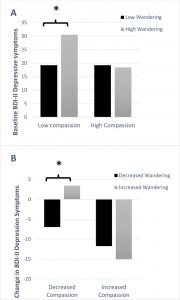Improve the Behavior of Prisoners and Prison Staff with Mindfulness
By John M. de Castro, Ph.D.
“I have seen how men in maximum security prison were able to support not only their own resilience, but also that of their guards, nurses, and other prison staff, through the practice of meditation, mindfulness, and deliberate kindness.” – Doug Carnine
Around 2 ¼ million people are incarcerated in the United States. Even though prisons are euphemistically labelled correctional facilities very little correction actually occurs. This is supported by the rates of recidivism. About three quarters of prisoners who are released commit crimes and are sent back to prison within 5-years. The lack of actual treatment for the prisoners leaves them ill equipped to engage positively in society either inside or outside of prison. Hence, there is a need for effective treatment programs that help the prisoners while in prison and prepares them for life outside the prison.
Contemplative practices are well suited to the prison environment. Mindfulness training teaches skills that may be very important for prisoners. In particular, it puts the practitioner in touch with their own bodies and feelings. It improves present moment awareness and helps to overcome rumination about the past and negative thinking about the future. It also relieves stress and improves overall health and well-being. Finally, mindfulness training has been shown to be effective in treating depression, anxiety, and anger. It has also been shown to help overcome trauma in male prisoners.
In today’s Research News article “Mindfulness-Based Stress Reduction in Prison: Experiences of Inmates, Instructors, and Prison Staff.” (See summary below or view the full text of the study at: https://www.ncbi.nlm.nih.gov/pmc/articles/PMC6745607/), Bouw and colleagues examine the effectiveness of the Mindfulness-Based Stress Reduction (MBSR) program for prisoners. They recruited male prisoners, staff, and instructors from prisons in the Netherlands where the prisoners had attended an MBSR program. The MBSR program consisted of 8 weekly 2-hour group sessions involving meditation, yoga, body scan, and discussion. The prisoners were also encouraged to perform practice on their own for 45 minutes for 6 days per week.
The prisoners were administered a semi-structured interview to obtain the prisoners’ views of level of satisfaction and challenges regarding the program as well as potential effects on stress responsivity, coping style, impulse control, aggression, and self-esteem. The staff members and instructors were also interviewed about the effects or changes they observed in the inmates who underwent the intervention. The prisoners were highly appreciative of the program with 82% attending all MBSR sessions and 64% completing all homework assignments.
The prisoners reported that after the program they had significant decreases in both the frequency and intensity of experiencing anger, that they were better able to handle the anger when it did arise, and were more likely to seek solutions to the situation that evoked the anger. They also reported a significant reduction in their reactions to stress, that they were more likely to be relaxed, and less likely to be sad or silent after stress. The prisoners also reported that they were more likely to employ cognitive-oriented coping styles and less emotion-oriented coping styles after the Mindfulness-Based Stress Reduction (MBSR) program. Finally, the prisoners reported a significant increase in self-esteem. The prison staff, and instructors reported that the prisoners had overall improvements in their behavior after the MBSR program including reduced stress responses, anger, aggressive behavior, and hostility and increased self-esteem, emotional stability, dealing with difficult emotions, problem solving skills, and regulation of aggression.
It has to be recognized that there was no control, comparison, condition. As such the results are open to confounding factors such as demand characteristics, placebo effects, time-based changes, etc. Nevertheless, the results are very encouraging. Even if they are due to confounding factors rather than the Mindfulness-Based Stress Reduction (MBSR) program, there was a significant improvement in the prisoners. From a practical standpoint that was the intent of the program in the first place.
So, improve the behavior of prisoners and prison staff with mindfulness.
“By working with both prisoners and correctional facilities professionals, mindfulness programs systematically transform the impact of our criminal justice system. Through cultivating greater awareness and compassion, mindfulness “encourages a shift away from fear-based and often anti-social or criminal strategies for meeting needs” – Prison Mindfulness Institute
CMCS – Center for Mindfulness and Contemplative Studies
This and other Contemplative Studies posts are also available on Google+ https://plus.google.com/106784388191201299496/posts and on Twitter @MindfulResearch
Study Summary
Bouw, N., Huijbregts, S., Scholte, E., & Swaab, H. (2019). Mindfulness-Based Stress Reduction in Prison: Experiences of Inmates, Instructors, and Prison Staff. International journal of offender therapy and comparative criminology, 63(15-16), 2550–2571. doi:10.1177/0306624X19856232
Abstract
Mindfulness intervention aims to reduce stress and to improve physical and mental health. The present study investigated feasibility and effectiveness of mindfulness intervention in a prison context, in both a qualitative and quantitative fashion. Specifically, the mindfulness-based stress reduction (MBSR) intervention was investigated, in a retrospective pre–post design, in five Dutch prisons. Twenty-two inmates (out of 25 approached, mean age: 40.1 years (SD = 11.1), convicted of murder, manslaughter, sexual offenses, drug offenses, robbery with violence, and/or illegal restraint/kidnap, and sentenced to incarceration between 15 and 209 months (M = 5.5 years; SD = 3.8) took part in a semistructured interview after completion of the MBSR intervention. The interviews addressed level of satisfaction and challenges regarding the MBSR intervention as well as potential effects on stress responsivity, coping style, impulse control, aggression, and self-esteem. Ten staff members and four MBSR instructors were interviewed about their own practical issues experienced while providing or facilitating the MBSR intervention, and about the effects or changes they observed in the inmates who underwent the intervention. Both participants and instructors/prison staff reported improvements in all of the addressed domains and expressed satisfaction with the intervention. Challenges were mainly identified in practical issues regarding the organization of the intervention sessions. Future studies should investigate mindfulness in longitudinal randomly controlled designs, should strive for a multi-method approach, and distinguish inmates according to personality characteristics.
https://www.ncbi.nlm.nih.gov/pmc/articles/PMC6745607/









